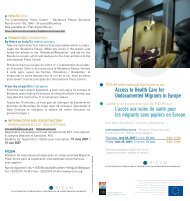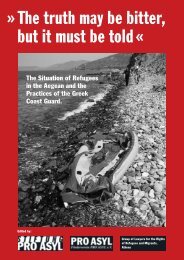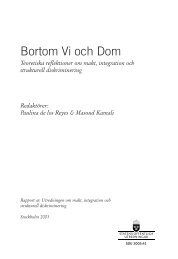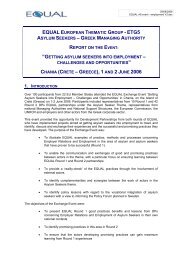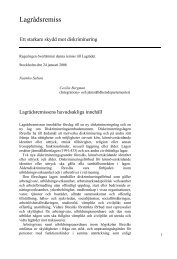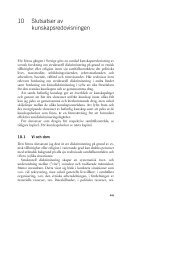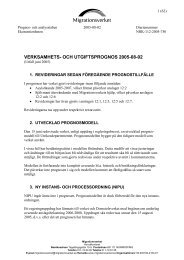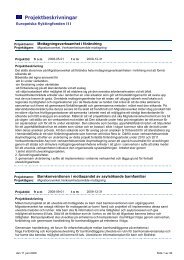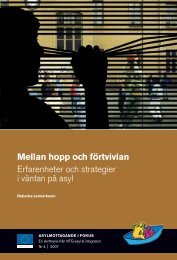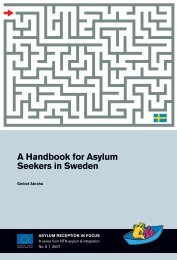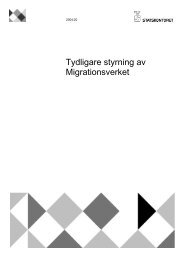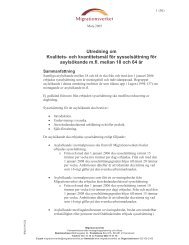and the Construction of Vulnerability - Child Trafficking
and the Construction of Vulnerability - Child Trafficking
and the Construction of Vulnerability - Child Trafficking
You also want an ePaper? Increase the reach of your titles
YUMPU automatically turns print PDFs into web optimized ePapers that Google loves.
paigns, <strong>and</strong> measures to rescue <strong>and</strong> repatriate VoTs are counterproductive in <strong>the</strong><br />
effort to secure human <strong>and</strong> child rights. The growing emphasis on security <strong>and</strong> law<br />
<strong>and</strong> order actually helps to fuel a cl<strong>and</strong>estine system <strong>of</strong> migrant-mobility within<br />
which services such as <strong>the</strong> facilitation <strong>of</strong> illegal migration <strong>and</strong> underground travel<br />
are supplied to those who want <strong>and</strong> need to cross borders. 102 In o<strong>the</strong>r words, stronger<br />
border controls lead to increased dependence on third parties in <strong>the</strong> migration<br />
process, <strong>and</strong> so heighten ra<strong>the</strong>r than reduce both adult <strong>and</strong> child migrants’ vulnerability<br />
to abuse <strong>and</strong> exploitation, also to extortion by corrupt border guards. 103 Fur<strong>the</strong>rmore,<br />
<strong>the</strong>y place migrants’ lives at risk, <strong>and</strong> have led to adults <strong>and</strong> children<br />
drowning on <strong>the</strong> way from Africa to Italy <strong>and</strong> Spain, suffocating in sealed containers<br />
<strong>and</strong> starving in locked trucks as <strong>the</strong>y tried to enter <strong>the</strong> EU, being blown to pieces<br />
by l<strong>and</strong>mines between Turkey <strong>and</strong> Greece <strong>and</strong> so on. 104<br />
Critics fur<strong>the</strong>r argue that measures to rescue <strong>and</strong> return VoTs are unlikely to seriously<br />
impact on <strong>the</strong> problem until <strong>the</strong> conditions that prompt children to migrate<br />
are transformed. A report by International Social Service Italy based on analysis <strong>of</strong><br />
a sample <strong>of</strong> 256 Albanian children repatriated from Italy to Albania between 1998<br />
<strong>and</strong> 2000 found that by 2001, “only 98 <strong>of</strong> <strong>the</strong> repatriated children were still in Albania,<br />
while 155 had emigrated again.” Only 6 had managed to find a job in Albania. 105<br />
More generally, however, <strong>the</strong>re is a lack <strong>of</strong> studies evaluating <strong>the</strong> impact <strong>of</strong> anti-trafficking<br />
measures on children, <strong>and</strong> in particular, on what happens to repatriated VoTs<br />
after <strong>the</strong>ir return.<br />
In addition to <strong>the</strong> above, <strong>the</strong> dominant discourse on “child trafficking” sometimes<br />
reproduces racist stereotypes about particular groups <strong>of</strong> migrants, <strong>and</strong> <strong>the</strong>reby<br />
streng<strong>the</strong>ns <strong>the</strong> stigma that attaches to <strong>the</strong>m. For example, Roma communities in<br />
Europe are singled out for attention as both victims <strong>and</strong> perpetrators <strong>of</strong> “child trafficking”.<br />
All too <strong>of</strong>ten, anecdotal information <strong>and</strong> stereotypes about Roma people<br />
st<strong>and</strong> in place <strong>of</strong> reliable research <strong>and</strong> careful analysis <strong>of</strong> <strong>the</strong> nature <strong>and</strong> causes <strong>of</strong><br />
migrant Roma children’s vulnerability to exploitation. The term “trafficking” is being<br />
used to blur all distinction between criminal activities, traditional practices <strong>and</strong> survival<br />
strategies on <strong>the</strong> part <strong>of</strong> communities that are already socially excluded. 106<br />
6.1.5 Education, Migration <strong>and</strong> Labour Exploitation<br />
As noted above, education migration cannot always be neatly separated from labour<br />
migration. In some cases, this can lead to severe exploitation. A recent report on contemporary<br />
forms <strong>of</strong> slavery in Bolivia, for example, notes that <strong>the</strong>re have been cases<br />
in which children are “loaned” to <strong>the</strong> owners <strong>of</strong> private ranches in return for being<br />
educated: “The children are given to <strong>the</strong> ranch owner for a year or so, <strong>and</strong> are expected<br />
to work in <strong>the</strong> employer’s house in exchange for being enrolled in school. However,<br />
<strong>the</strong> children find that <strong>the</strong>ir labour is not considered sufficient for <strong>the</strong> exchange<br />
102. Kapur, 2005a, p. 28; ILO, 2002a<br />
103. see Bastia, 2005<br />
104. UNITED, 2007<br />
105. Rozzi, 2002, p. 19<br />
106. Karoly, 2006<br />
36<br />
<strong>Child</strong> Migration <strong>and</strong> <strong>the</strong> <strong>Construction</strong> <strong>of</strong> <strong>Vulnerability</strong>




